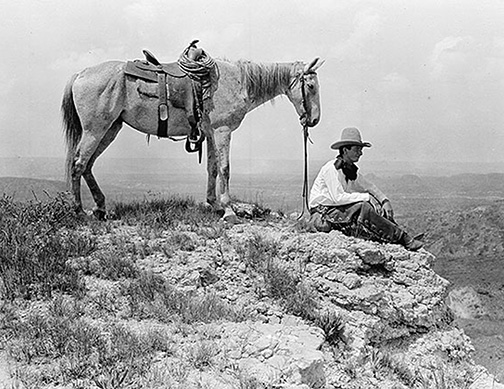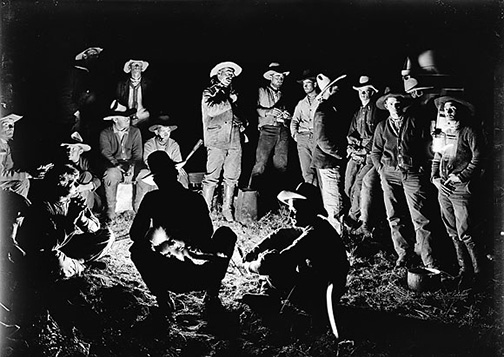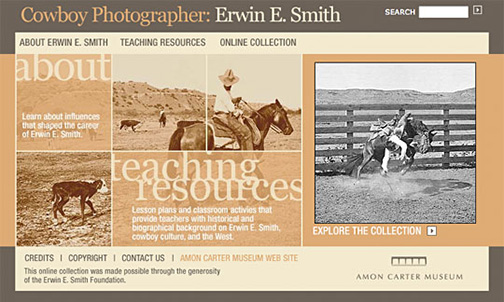
Erwin E. Smith and His Mount Overlooking the Country from a High Point on the JA Ranch
Reproduced with permission of the Amon Carter Museum
Cowboy photographers
Photographers also followed the cattlemen and cowboys to West Texas. Some of the cowboys themselves became photographers and recorded cowboy and ranch life with their images.
Ray Rector (1884–1933) grew up in the Brazos River Canyonlands in Fisher County as a cowboy and later worked on the famous XIT Ranch in the Texas High Plains. In 1902 he returned to the Brazos River area becoming a photographer in Stamford recording ranch scenes, including images from the SMS Ranch, portions of which were in Fisher County and Stonewall County. Rector called himself the “Cowboy Photographer.” (The Handbook of Texas)
Texas A&M University published a collection of his photographs in an 1982 book Cowboy Life on the Texas Plains. The Harry Ransom Humanities Research Center at the University of Texas holds a large collection of his negatives and prints.

Shoe Bar Chuck Wagon, Hoodlum Wagon and Some of the Boys
Reproduced with permission of the Amon Carter Museum
The Amon Carter Museum's major collection of photography emphasizes the American West and includes the photographs of Erwin E. Smith. The museum's Online Collection of Smith's images constitutes “some of the most important photographs of cowboy life on record.”
This collection contains many photographs from ranches in the Texas Canyonlands including the JA, Matador, Spur and SMS ranches,including the self portrait shown above made in 1906 by Erwin E. Smith as a cowboy on the JA Ranch (owned in part by Charles Goodnight) looking out over the Texas Canyonlands.

Cowpunchers of the Matador listening to the “Pitchfork Kid” Billy Partlow (standing in center with pipe), famous for his story telling
Reproduced with permission of the Amon Carter Museum
Cowboy Photographer
Erwin E. Smith
Erwin E. Smith (1886–1947) always wanted to be a cowboy and an artist. When he was a boy growing up in Bonham, a town in Fannin County in North Texas, the era of the great trail drives was over, and he feared that the old ways of the cowboy were disappearing. However, the legend and myth of the cowboy was just beginning. Popular literature, art by Frederic Remington and Charles M. Russell, and the fledgling film industry promoted a romantic, yet often inaccurate, image of the cowboy. For his part, Smith resolved to honor the life of the cowboy by presenting as true a portrayal as possible.
Aware that an artist must know his subject intimately to capture details accurately, Smith took every opportunity to gain experience as a working cowboy. As a boy he spent summers on his uncle's ranch near Quanah, Texas. The land bordered the Great Western Cattle Trail, which thousands of longhorns followed north in the 1880s. During the summers, he began to acquire the skills to be a cowhand.
Smith attended two of the best art schools in the country to study sculpture and painting. But eventually he chose photography as his way to preserve a record of the open-range cowboy life. Between 1905 and 1912, he photographed roundups and other scenes on ranches in Texas, New Mexico, and Arizona. Smith's photographs, showing both the romance and harshness of cowboy life, are some of the best-known images of the southwestern range early in the last century.

Amon Carter Museum Online Collection
To view over 750 online reproductions of Erwin Smith's photographs, browse through this exceptional presentation by the Amon Carter Museum Online Collection:
- Cowboy Photographer: Erwin E. Smith (This online collection is no longer available.)
brazosrivercanyonlands.com is published by Jim Watson and licensed
under a Creative Commons Attribution-NonCommercial 4.0 International License.